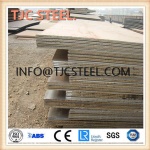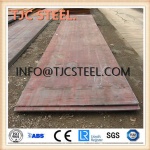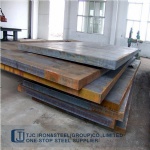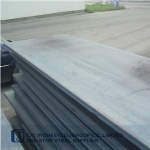Tel: +86-371-86107816
Fax: +86-371-63797816
E-mail: info@tjcsteel.com
Add: Fortune Plaza, Zhengzhou, Henan, China
Skype: tjccarl


|
Product name : A387Gr9CL1/A387 Grade 9 Class 1 Chromium-Molybdenum Alloy Steel Plates for Pressure Vessels and Boilers
Item : 202481117223
 |
| Details: |
Introduction
A387Gr9CL1/A387 Grade 9 Class 1, a premium-grade chromium-molybdenum alloy steel plate, has been specifically engineered to meet the stringent demands of the petrochemical and thermal power generation industries. Manufactured under the strict ASME SA-387/SA-387M-2017 and ASTM A387/A387M-17 standards, these plates offer exceptional high-temperature performance, corrosion resistance, and mechanical strength. In this article, we delve into the chemical composition, mechanical properties, heat treatment states, dimensional ranges, impact testing requirements, primary applications, and supply cases by TJC Steel Group. Chemical Composition The A387Gr9CL1/A387 Grade 9 Class 1 plates are formulated with a carefully balanced chemistry to ensure optimal performance. The primary alloying elements are chromium (Cr) and molybdenum (Mo), with minor additions of vanadium (V) and niobium (Nb) to enhance specific properties. The typical chemical composition ranges are as follows: - Carbon (C): 0.05-0.15% - Silicon (Si): ≤ 0.50% - Manganese (Mn): 0.30-0.60% - Phosphorus (P): ≤ 0.025% - Sulfur (S): ≤ 0.035% - Chromium (Cr): 8.00-9.50% - Molybdenum (Mo): 0.85-1.05% - Vanadium (V) & Niobium (Nb): Trace amounts for specific property enhancements Mechanical Properties These plates exhibit exceptional mechanical properties, making them ideal for high-temperature and high-pressure applications. The A387Gr9CL1/A387 Grade 9 Class 1 plates offer: - High tensile strength and yield strength - Excellent creep resistance - Good ductility and toughness - Superior low-temperature toughness Typical mechanical property values include: - Tensile Strength: ≥ 585 MPa - Yield Strength (0.2% Offset): ≥ 415 MPa - Elongation in 2" (50 mm): ≥ 18% Heat Treatment States The heat treatment process for A387Gr9CL1/A387 Grade 9 Class 1 plates is designed to optimize their microstructure and mechanical properties. The plates are typically heat-treated using one of the following methods: 1. Annealing, normalizing, followed by tempering. 2. If agreed upon by the purchaser, accelerated cooling from austenitizing temperature using air or liquid quenching, followed by tempering. The minimum tempering temperature is 675°C. If no specific heat treatment is indicated, the plates are delivered in the stress-relieved or annealed condition. Dimensional Ranges A387Gr9CL1/A387 Grade 9 Class 1 plates are available in a wide range of dimensions to suit various application requirements. Typical dimensional ranges include: - Thickness: 8 mm to 350 mm - Width: 1600 mm to 2500 mm - Length: 5000 mm to 12000 mm Custom sizes can also be produced upon request. Impact Testing To ensure the plates' resilience in low-temperature environments, impact testing is performed. The specific impact testing requirements depend on the intended application and may include Charpy V-notch impact tests at various temperatures. Primary Applications A387Gr9CL1/A387 Grade 9 Class 1 plates find extensive use in the petrochemical and thermal power generation industries, where they are exposed to extreme temperatures, pressures, and corrosive environments. Key applications include: - Superheated steam pipes and boilers - Reactors and pressure vessels - Heat exchangers - Petrochemical piping and tanks - High-temperature flanges and fittings |
| Related Products : |



 Copper Alloy Plate
Copper Alloy Plate
 ASME SA285/ SA285M Pressure Vessel Steel
ASME SA285/ SA285M Pressure Vessel Steel













